5 important things to know if you're taking pictures at the beach and in the surf
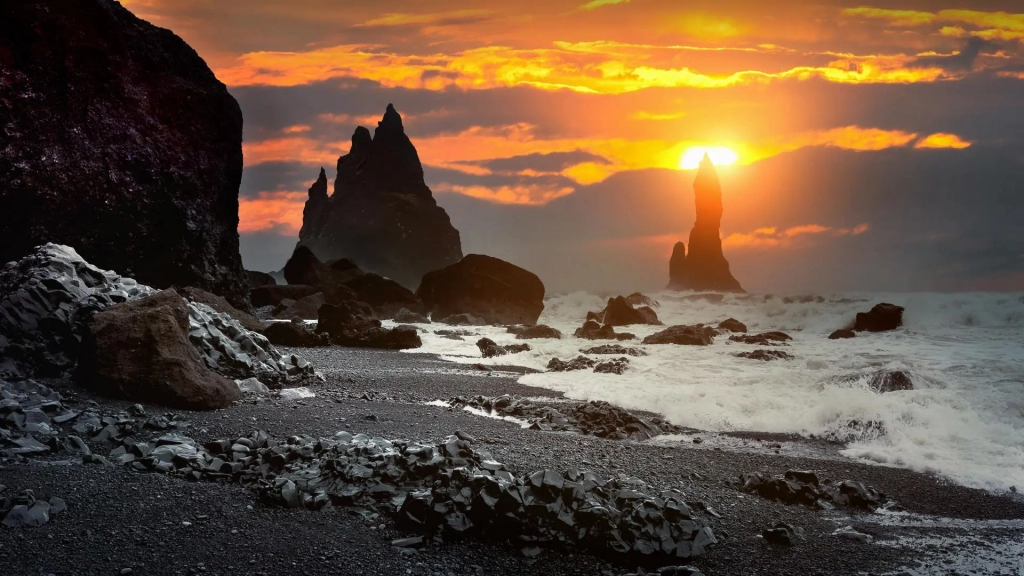
I love taking landscape photos at the beach. It is an ever-changing landscape dominated by the sea and its waves. You may think that taking photos in such a place is easy, but you need to know a few things before going there. Especially for your safety.
I have decided not to write about settings and equipment in general. We will certainly talk about it in another article in the coming days. In this article I want to talk about the things you need to watch out for. However, let me say a few words about using filters.
Learn about exposure times and filters
You'll probably want to use filters to capture the movement of the water. Often dark neutral density filters are used, such as the famous Lee Big Stopper or similar 10 stop filters, such as the Haida Red Diamond .
But you have to realize, the longer the exposure duration, the less motion will be captured. Make the exposure long enough and the water will turn into a flat, calm surface.
If you really want to capture the dynamics of the water, keep the exposure duration between 1/4 second and 2 seconds, depending on the direction of the water and its speed. Choose the neutral density filter that allows you to use the desired exposure length. Don't just choose a neutral density filter and use the exposure time you get.
In addition to the settings and filters you use, there are other things to keep in mind when photographing at the beach and in the surf. These are not often mentioned, but are very important nonetheless.
1. Know the beach and its risks
Shooting on a beach can be quite dangerous if you are not familiar with the characteristics of that beach. The surf can be very unpredictable or the tides can rise faster than you think. Knowing what to expect will make shooting at the beach much safer. I have some examples.
Tides at the Opal Coast
The tides on the Opal Coast in France vary between one and nine metres. It means that the sea will sometimes rise more than a meter per hour, which is a lot. If you're not careful, you could get trapped on a rock with no way back to safety. You must keep an eye on the water level at all times and make sure your way back is not blocked by rising water.
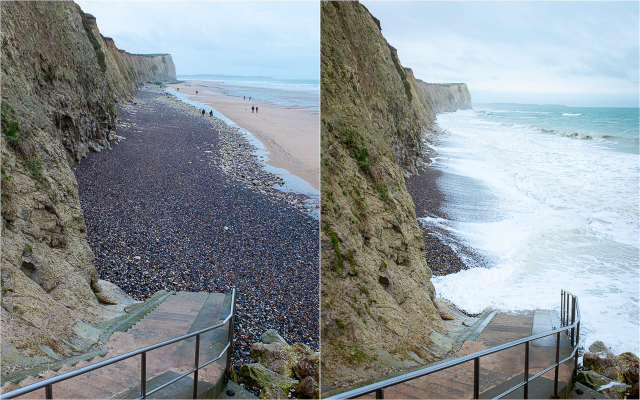 The tidal difference at the Opal Coast is seen in this comparison. The time between the two images is only an hour and a half.
The tidal difference at the Opal Coast is seen in this comparison. The time between the two images is only an hour and a half.
Boulders at Unstad beach
Part of Unstad beach in Lofoten, Norway is covered with huge boulders. Photographing the flow of water between boulders can produce fantastic images, until that big wave you didn't see coming hits you. Whatever you're doing, don't grab your camera and tripod, walking quickly backwards. I've seen some photographers do it, with the risk of tripping over some big boulder behind them, thus risking hitting their heads against another boulder.
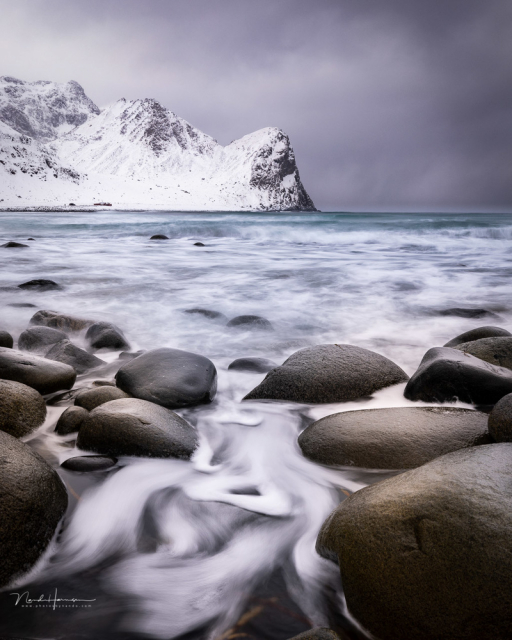 These boulders are a great subject. But if you find yourself in the way, don't run away if a wave hits you. It is too dangerous. Photo by Nando Harmsen
These boulders are a great subject. But if you find yourself in the way, don't run away if a wave hits you. It is too dangerous. Photo by Nando Harmsen
Sneaker Waves a Try
You probably know the famous Reynisfjara beach in Iceland, where large sea stacks called Reynisdrangar offer great compositions. Many tourists and photographers have been surprised by sneaky waves. Even if the surf is calm and you may think you are at a safe distance, a sneaky wave can always overwhelm you. It has happened and, almost every year, they cause deaths.
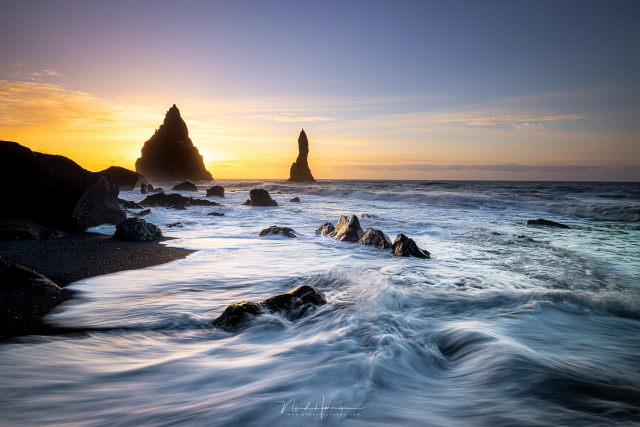 The black beach of Reynisfjara in Iceland. It is a dangerous beach due to the sneaky waves. Trust me, they will surprise you. Photo by Nando Harmsen
The black beach of Reynisfjara in Iceland. It is a dangerous beach due to the sneaky waves. Trust me, they will surprise you. Photo by Nando Harmsen
2. Position the tripod in the right way
Not all beaches are as dangerous as the three examples I mentioned. Some beaches are relatively safe and not many extra precautions are needed. If so, you can place your tripod in the surf itself to capture the pattern created by the movement of the water.
If you do, make sure your tripod is positioned correctly. Push it firmly into the sand or set it up so it's as stable as possible on the rocks. Always point two tripod legs towards the water flow and one leg with the direction of the water. At sea, with water flowing in both directions, determine which direction has more force and set up the tripod accordingly.
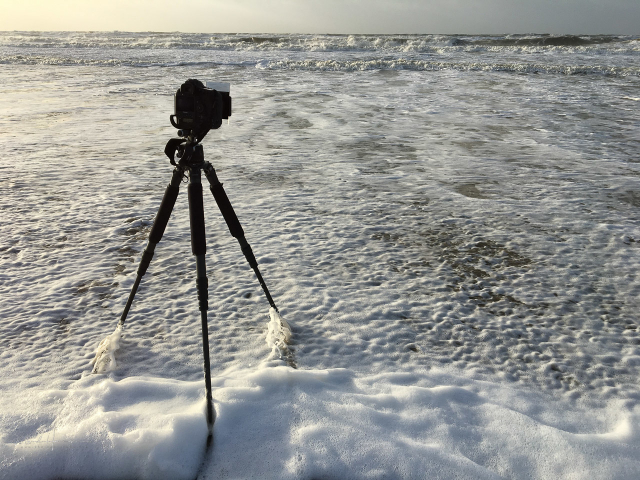 The correct way to place the tripod, with one leg in the direction of the water movement.
The correct way to place the tripod, with one leg in the direction of the water movement.
By positioning the tripod this way, there will be less risk of it tipping over if a wave hits it. However, water has a lot of force and is heavy (a cubic meter of water weighs a thousand kilograms, imagine if it hits you), which means it can move even the heaviest of tripods. Always stay close to the tripod so you can keep it upright if a wave hits it too hard.
3. Never leave your camera bag unattended
Whatever you're doing, be careful where you open your camera bag. I have seen photographers place their camera bag very close to the surf. Some even leave the bag open and walk away leaving it unattended. If you do, you may end up with your camera bag filled with seawater. In the past, I've saved the bags of some photographer friends, even though I warned them of the risk.
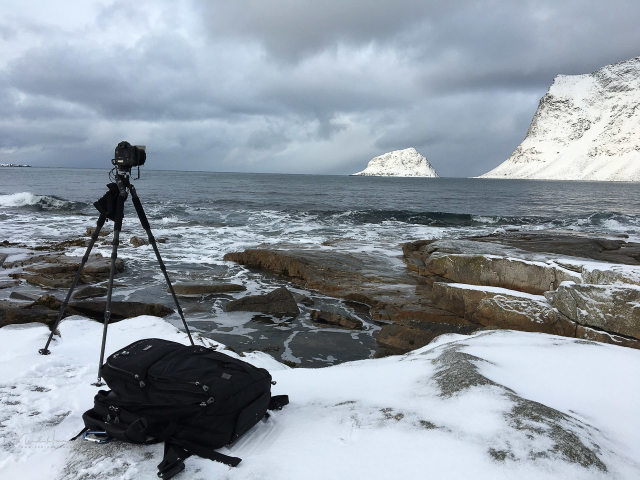 You may think you are safe placing your camera bag in that spot, but the next wave may overtake it. Do you want to take the risk?
You may think you are safe placing your camera bag in that spot, but the next wave may overtake it. Do you want to take the risk?
Never take any risks at sea. If you want to change lenses or need to take something out of your bag, place it at a safe distance from the surf, preferably on higher ground, and always keep an eye on the sea and the waves. If you're done, take the bag with you again. Never leave it unattended or exposed to the risk of a huge wave that can fill it with water or worse yet wash it away.
4. Always carry a towel with you
No, this has nothing to do with the most important rule in The Hitchhiker's Guide to the Galaxy. But yes , it has a lot to do with keeping the camera and lens free from water. Especially when shooting from a low angle, the risk of water entering the lens is very high. In this case, you don't want a regular towel, but a tea towel. Make sure it has been washed several times as this way it will be free of fibers and loose particles.
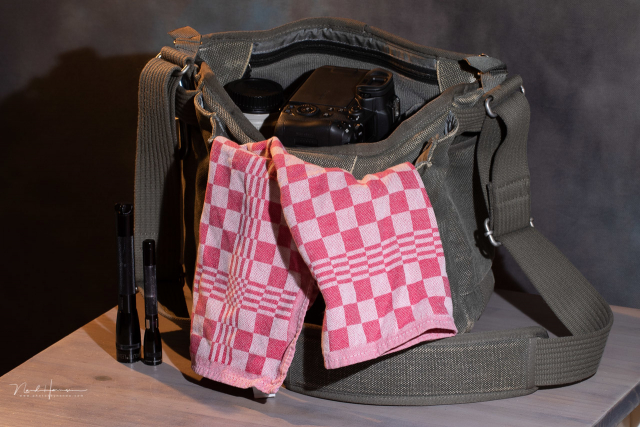
A tea towel can also protect your camera and lens from rain or snow. It will also help when shooting at waterfalls, for example, I used it when I shot at the Marmore waterfall. In short, it's just a very useful thing that makes shooting at sea and in the surf much easier.
5. Clean the tripod afterwards
You know that sea water is salty. If the water dries up, the salt will remain. Any metal on your tripod will corrode much faster if you don't clean it. The tripod legs, which are often made of carbon, are safe. But the screws and other metals present won't do as well. That is why it is advisable to thoroughly clean the tripod afterwards.
You don't need to start cleaning the moment you get home; but doing it as soon as possible is definitely the best thing to do.
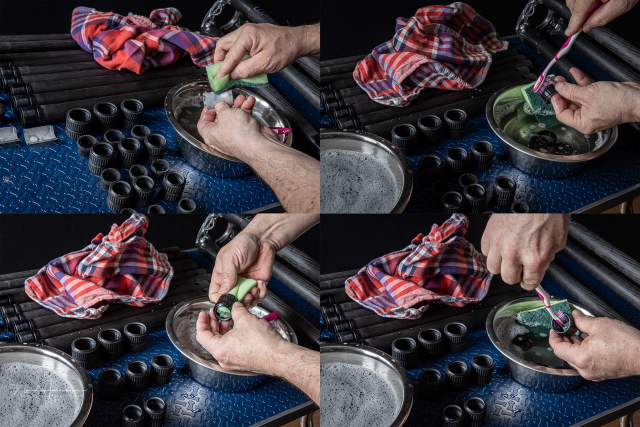
It might also be wise to clean the camera. If parts of your camera turn white over the next few days, you know that seawater has come into contact with them. Take special care of the slide because it is one of the places on the camera where salt can cause the most damage. There are electrical contacts to communicate with a flash or flash trigger. The salt will ruin this connection eventually if you're not careful. Use a wet cloth to rinse the camera and remove the salt. As you can see, the tea towel also comes in handy after you've finished taking pictures. After all, Ford Prefetch from The Hitchhiker's Guide to the Galaxy may be positively right.
When you subscribe to the blog, we will send you an e-mail when there are new updates on the site so you wouldn't miss them.
By accepting you will be accessing a service provided by a third-party external to https://www.insightadv.it/


































































Comments